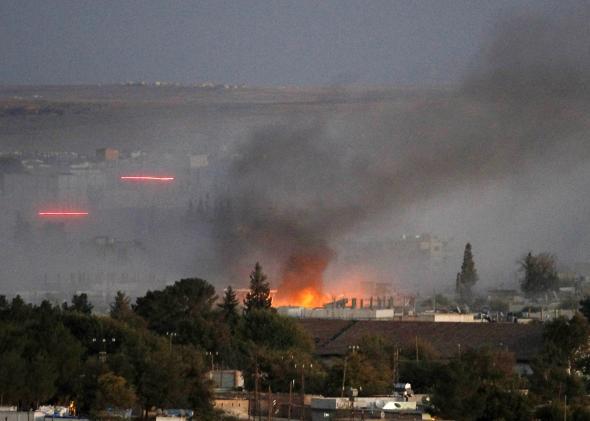Even if it’s not the actual reason why the U.S. and its allies have launched a campaign of airstrikes against ISIS, most Americans support the operation due to fear that the group could carry out terrorist attacks here at home. (Rightly or wrongly, those fears will only increase after last week’s events in Canada.) Public awareness of ISIS also grew here thanks to the videotaped beheadings of American journalists—indisputably acts of terrorism.
At the same time, most of what ISIS does is not traditionally considered terrorism. (Before you skip straight to the comments, this is a discussion of tactics, not morality. Let’s stipulate that ISIS is an abominable organization.) Most of the violence it commits is in the context of fights for territory with rival national militaries and militia groups, though civilians are often targeted by both sides. Its primary goal is to expand and administer its territory. Purely terrorist groups don’t run consumer protection bureaus.
This distinction is discussed in a recent article in the journal Perspectives on Terrorism. That article categorizes ISIS, along with Hezbollah and Hamas, as organizations classified as terrorist groups by the United States and its allies but that spend most of their time and resources on activities other than terrorism. The authors, Assaf Moghadam, a counterterrorism researcher at the Interdisciplinary Center (IDC) in Herzliya, Israel (whose work I’ve previously written about here), Ronit Berger, a Ph.D. candidate at Syracuse University, and Polina Blieakova, an M.A. student at IDC, go further, arguing that most groups we consider to be terrorist organizations only spend part of their time on terrorism.
Even al-Qaida, which undoubtedly made its reputation with acts of international terrorism, spends most of its time as a militia group fighting in various civil conflicts around the world. It “conducts terrorism on the side—almost certainly its least-resourced component,” as the counterterrorism researcher J.M. Berger puts it.
The authors looked at the data on terrorist attacks between 2002 and 2012 in the START database at the University of Maryland, the most comprehensive listing of terrorist activity around the world. The 119 active groups in the Maryland data set target civilians 32.33 percent of the time—the rest are a combination of military, government, and police targets.
Al-Qaida in the Islamic Maghreb and Al Qaida in the Arabian Peninsula both targeted the military more than any other target. Interestingly, the most active non-Islamist movements—including Joseph Kony’s Lord’s Resistance Army and the Fatah-linked Al-Aqsa Martyr’s Brigade—target civilians more often than the Islamists.
The only group in the database that exclusively attacked civilians was Angola’s UNITA, which attacked six civilian targets during the period. For what it’s worth, UNITA was once a major recipient of U.S. military aid during the Cold War and today is a major political party.
Obviously, many attacks on government targets would still be considered acts of terrorism by most people. But this data, combined with the fact that the vast majority of acts of “terrorism” take place in the context of civil wars and insurgencies, makes it clear that the distinction between terrorists and rebels or guerilla fighters is a blurry one. Many of the enemies in the U.S.-led war on terror may be worthy targets, but they’re only part-time terrorists.
The authors argue that “by conceiving of its opponents as insurgent groups [rather than simply as terrorists], governments can also widen the scope of their policy efforts. Besides aiming at the tactical defeat of the adversary using military means, the insurgency framework highlights the necessity of simultaneously focusing on reestablishing governmental credibility and gaining popular support in problematic areas. In this regard, addressing the social grievances upon which the insurgents’ political agenda is based should move to the top of the policy agenda.”
They argue that governments use the label terrorism less for descriptive specificity than for “emotional satisfaction.” They write: “Terrorism evokes repugnance and fear, thereby stoking an unequivocal rejection of terrorism’s means and agents alike. Populations have been trained to reject compromise with terrorists, and want to believe that terrorists are unique in their ‘evilness,’ therefore deserving a category of their own.”
For this reason, they argue, governments fighting these groups should continue to use the T-word in public statements to galvanize public opinion, even while understanding internally that it’s not the most accurate framing.
I’m not sure I’d go that far. The fear of terrorism may sometimes be used by governments to build support for reasonable public policy goals. But just as often, if not more often, it leads to restrictions of civil liberties and some seriously dumb ideas about, say, terrorists attacking the United States with the Ebola virus.
